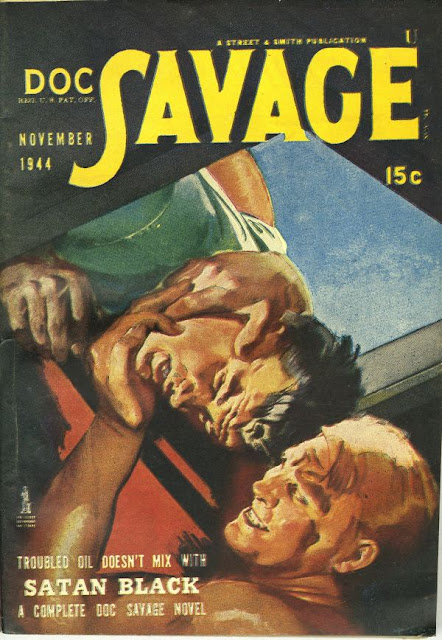Fictional heroes can come and go. A few come and stay. One such hero with staying power is Doc Savage, whose stories were written by "Kenneth Robeson," the pen name of several writers, but predominantly Lester Dent. I previously posted about Doc Savage here.
I would imagine that readers familiar with Doc Savage visualize him in terms of James Bama's depictions such as on the book cover shown above. Bama's first Savage cover appeared in 1964 and was followed by 61 others over the next 30 or so years. Subsequent images of Savage by other artists in other media retained Bama's concept of Savage's appearance.
The original Doc Savage illustrator was Walter Baumhofer who did the cover art for the Doc Savage pulp magazine series from 1933 until he began moving from pulp to "slick" magazines around 1936-37. Background information on Baumhofer can be found here, here and here.
The image above is a typical Baumhofer Doc Savage cover, this for May 1934. Since Savage was described as the "man of bronze" in the stories, referring to his coloration, Baumhofer indulged in a degree of artistic license by introducing violet shaded areas in his paintings to contrast with the bronze hues required by his subject.
For what it's worth, I consider Bama and Baumhofer (and not necessarily in that order where Doc Savage is concerned) as the best of the lot over the first half century of the character's existence. Which implies that other brushes were in the game.
The best of these was Robert G. Harris, a talented illustrator who had little choice but to follow Baumhofer's Doc Savage characterization and style, as can be seen in the two covers above. Biographical links for Harris are here and here.
Quality began to noticeably slide to my eyes when Emery Clarke became the main cover artist. His images are a little less distinct, lacking the punch Baumhofer and Harris delivered. One source contends that the figure in glasses in the upper image is a self-portrait of the artist.
Last and least among the Savage illustrators I located (and I must have missed some others) was former (almost bomb-throwing) anarchist Modest Stein, whose colorful career is described here. Whereas Baumhofer's images were classy (especially considering their pulp magazine locale) and Bama's were monumental (and not much like the physial description of Savage in the stories), Stein's strike me as little better than smudges in many cases, a step down from Clarke's work.







No comments:
Post a Comment